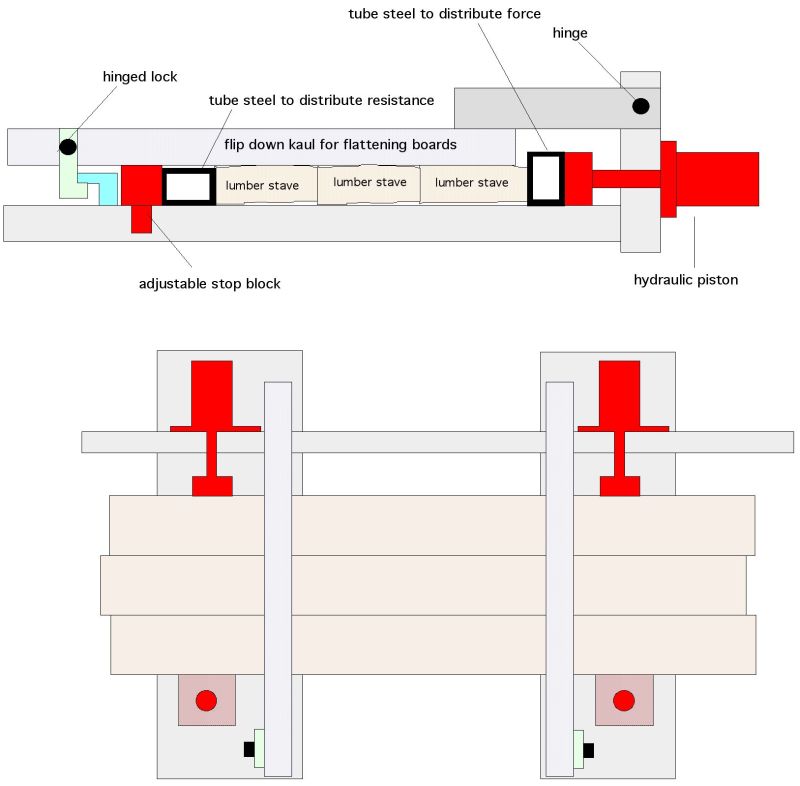Question
The bottleneck in one of our product families has moved to laminating lumber. Our current system utilizes a Larry's Clamp for flattening the boards and about 40 Jorgensen pipe clamps that are 36 inches long.
I would like to come up with a better way to clamp. Manhandling pipe clamps is time consuming. We don't have the space for a rotating Taylor Clamp. An idea under consideration is hydraulic pistons.
I don't have any experience with hydraulics other than the pistons that lift our scissor lift work benches. Can anybody identify flaws in this idea?
The lumber we are laminating has been jointed on one long edge and is reasonably straight. Our process right now involves clamping every 8 inches or so. I am thinking if we could deliver more power to the push we would not need as many clamps.
Would the hydraulics give us enough push to where we could do this with a metal kaul on both sides of the lumber and just two pistons, or would we need pistons every foot or so like the pipe clamps we currently use?

Forum Responses
(Cabinetmaking Forum)
From contributor L:
We've got a Taylor clamp rack. You can get them in most any size you want. Ours is 12' long with 6 rows of 36" clamps (I think 32" clamps are their norm, but we do fitting room doors on it so we ordered it with the 36" clamps). The clamps are the same as used on their rotary clamp racks, beefy! We have 36 clamps. You can order any amount. If you are gluing small panels you can work in the center and slide the glued panel to the side and slide the dry panel to the center work area. That way you are always working in the clear. If you have someone clamping all day it would be worth getting a power device for turning the clamp handles. At least to spin them up and then maybe hand tighten. I don't think you need clamps every 8" or can get them that close, with this clamping system. The jaws are 4.75 wide x 2.5 high and I think you can get taller ones too. If you really need production you could get an RF gluer.
As far as your question as to the number of cylinders you need it can be done with only one if you want. The issue is getting a pair of cauls that are either very stiff, or are a bit less stiff but have a bit of reverse crown in them so that they will spread the force uniformly along the glue joint. (Calculate the number of square inches of glue line times the clamping pressure per square inch recommended by your glue manufacturer. Then generate that much force by your cylinders (the area of their bore times the PSI of the system, times the number of cylinders).
There is no need for hydraulic cylinders. Air will work just as well, for your need. The only advantage to hydraulics is that you can run 3000 PSI instead of your shop pressure (allowing smaller bore diameter) and that it is easier to achieve precision control with a non-compressible fluid (hydraulic oil), than with a compressible gas (air). Neither of those should be an issue for you and you will be spared the expense of a hydraulic pump/reservoir, unless you calculate a need for so much pressure. (Although my family sold the business years ago, may I offer a recommendation for Ortman Fluid Power cylinders.)
We bought a JLT clamp rack like the ones the other guys are talking about and sold the pneumatic one. I think the clamp rack is one of the better value investments we have made. Save your time and money and put it toward a clamp rack.
Your idea for a clamp would take the same schematic and valving as a simple log splitter uses - it's a well understood science.
The two main enemies of hydraulics are overheated hydraulic oil and contaminates in the oil. Heat is best dealt with by having a large reservoir and heat exchangers. Dirt and water can be filtered out. The volume of the cylinder(s) and the volume of the pump need to be studied and matched - insufficient volume will make the ram(s) move too slowly for your likes. Put a scatter shield in place so you don't spray oil all over the shop if/when a hose breaks.
I think a dedicated hydraulic clamping system would be pretty slick, but only if it were coupled with an rf glue heater - otherwise, I'm having trouble seeing an advantage worth the cost. With an rf heater, I suspect such a system would crank out a lot of volume from a small footprint.